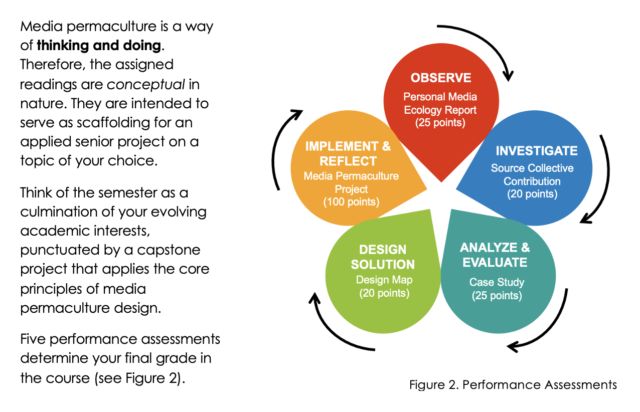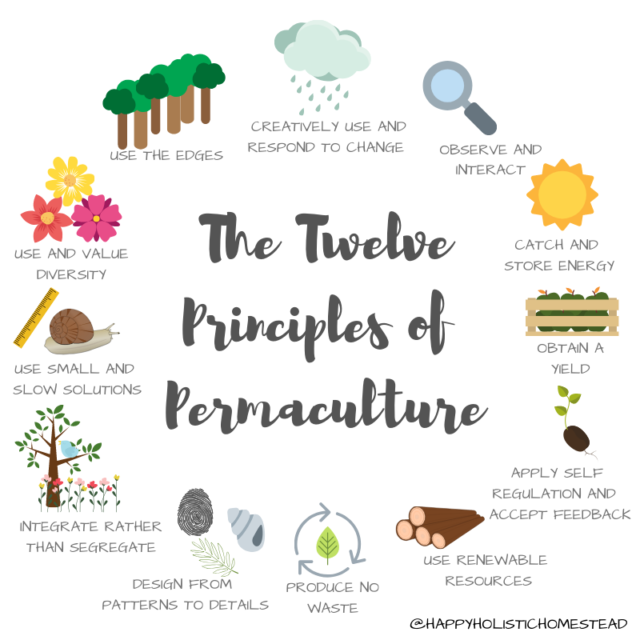Recently (2024-2025) I developed an undergraduate senior seminar (capstone) on the topic of media permaculture design. Students explore the intersection of media studies and permaculture principles. The focus is creating sustainable, ethical, and regenerative communication practices in our rather chaotic post-digital age. Students engage in sustainable storytelling, media production, and ethical communication. Through critical analysis of media ecosystems, students create individualized capstone projects that promote ecological balance, social equity, and economic resilience.
Course objectives:
- Reflect on the costs and benefits of one’s own media environment and wider media ecology.
- Understand permaculture principles and their application to communication and media environments.
- Empirically observe the elements comprising a particular media landscape.
- Access, analyze, and evaluate credible source material about a current dilemma within a specific media ecology.
- Explore permaculture ethics in media content and practice
- Assess the impact of media consumption on both micro and macro levels.
- Communicate clearly (both visually and in writing) a permaculture solution to a communication and media problem or challenge.
- Create multimedia content according to principles of sustainability.
- Responsibly share knowledge of sustainable solutions.
Required Reading:
(PERSONAL MEDIA ECOSYSTEMS)
- Sreberny-Mohammadi, A. (1995). Forms of media as ways of knowing. In J. Downing, A. Mohammadi, & A. Sreberny-Mohammadi (Eds.), Questioning the Media: A Critical Introduction (pp. 23-38).
- Shlain, T. (Director). (2011). Connected. [Film]. Let it Ripple Studio.
- Parry, D. A., & le Roux, D. B. (2020). Introducing the Media Use Behaviour Conceptual Framework. Responsible Design, Implementation and Use of Information and Communication Technology: 19th IFIP WG 6.11 Conference on e-Business, e-Services, and e-Society, I3E 2020, Skukuza, South Africa, April 6–8, 2020,
- Rauch, J. (2018). Slow Media: Why “slow” is satisfying, sustainable, and smart. Oxford University Press.
- [Chapter 2: “Slow Media: Lessons from the Food Revolution”]
- [Chapter 5: “Mind Your Media”]
- Toffler, A. (1970). Things: The throw-away society. In Future Shock (chapter four). Random House.
(CASE STUDY IN MEDIA PERMACULTURE: AMAZON, INC.)
- Jacoby, J. (Director) (2020). Amazon Empire: The Rise and Reign of Jeff Bezos [Film]. PBS Frontline.
- Wallace M. & Carruthers, D. (2018). Introduction. In Perma/Culture: Imagining alternatives in an age of crisis (pp. 1-12). Routledge.
- Wiener, A. (2019). What an Amazon fulfillment center tour reveals. The New Yorker.
- Amazon—Market. Power! Monopoly? How Amazon hikes prices and copies product [Film]. Molson Hart.
- Hurst, K. (2022). Building a better future together: 2022 Amazon Sustainability Report Executive Summary. Amazon, Inc.
- Hurst, K. (2023). 2023 Amazon Sustainability Report Executive Summary. Amazon, Inc.
- Internet data centers are fueling drive to old power source: Coal. (2024, April 17). Washington Post.
- Trace, S. (2011). Responsibility in technology. Remarks given at the Responsibility in Economics and Bsuiness: The Legacy of E. F. Schumacher. European Spirituality in Economics and Society Forum.
(REGENERATIVE MEDIA PERMACULTURE DESIGN)
- Rothe, K. (2014). Permaculture design: On the practice of radical imagination. communication +1 (3)1. doi: 10.7275/R58913S2
- Ivakhiv, A., & Lopez, A. (2023). When do media become ecomedia? The Routledge Handbook of Ecomedia Studies (pp. 1-16). Routledge.
- Lopez, A. (2012). Evolving media ecosystems. In The media ecosystem: What ecology can teach us about responsible media practice. Evolver Editions.

SUPPLEMENTARY GRAPHICS

Feel free to reach out to me if you’d like to collaborate or implement these principles within your own teaching. Email me at vanessaegreenwood at gmail dot com